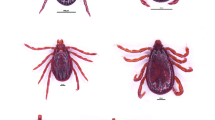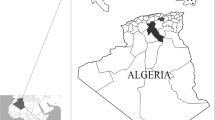Abstract
Dermacentor everestianus Hirst, 1926, is only reported in Northwestern China and Nepal. Few researches about this species have been involved, especially for molecular characteristics. The taxonomy studies of D.everestianus are mainly based on morphological features, and its taxonomic status is an ongoing controversy. To clarify the molecular characteristics and phylogenetic status of D.everestianus and other related species, the sequences of mitochondrial 16S ribosomal DNA (rDNA) and cox1 fragments were analyzed in the present study. Analysis of 16S rDNA and cox1 sequences showed 99.3–100 % identity within D.everestianus individuals, with the genetic divergence among them was 0–0.0086. The interspecific distance of 16S rDNA and cox1 between D.everestianus and some other Palaearctic species including D. silvarum, D. nuttalli, and D. marginatus was much smaller than that between D.everestianus and Nearctic Dermacentor ticks (D.albipictus, D.nitens, and D.variabilis). Such relationships of these ticks were also verified in the phylogenetic analysis. Two major clades were recovered within Dermacentor spp. with more than 90 % bootstrap support in the phylogenetic trees. D.everestianus together with D.silvarum, D.nuttalli, and D.marginatus were included in the clade I (Eurasia lineage). Other analyzed tick species including D.variabilis, D.nitens, and D.albipictus formed clade II, which are distributed in Nearctic realm. These indicated that the genus Dermacentor was at least composed of two lineages. Thus, further researches including additionally molecular markers on all Dermacentor species globally should be taken to precisely resolve relationships within Dermacentor.



Similar content being viewed by others
References
Apanaskevich DA, Duan W, Apanaskevich MA, Filippova NA, Chen J (2014) Redescription of Dermacentor everestianus Hirst (Acari: Ixodidae), a parasite of mammals in mountains of China and Nepal with synonymization of D.abaensis Teng and D.birulai Olenev. J Parasitol. doi: http://dx.doi.org/10.1645/13-369.1
Beati L, Keirans JE (2001) Analysis of the systematic relationships among ticks of the genera Rhipicephalus and Boophilus (Acari: Ixodidae) based on mitochondrial 12S ribosomal DNA gene sequences and morphological characters. J Parasitol 87:32–48
Black W, Roehrdanz RL (1998) Mitochondrial gene order is not conserved in arthropods: prostriate and metastriate tick mitochondrial genomes. Mol Biol Evol 15:1772–1785
Black WCI, Klompen JSH, Keirans JE (1997) Phylogenetic relationships among tick subfamilies (Ixodida: Ixodidae: Argasidae) based on the 18S nuclear rDNA gene. Mol Phylogenet Evol 7:129–144
Black WCI, Piesman J (1994) Phylogeny of hard and soft-tick taxa (Acari:Ixodidae) based on mitochondrial 16S rDNA sequences. Proc Natl Acad Sci U S A 91:10034–10038
Burger TD, Shao R, Beati L, Miller H, Barker SC (2012) Phylogenetic analysis of ticks (Acari: Ixodida) using mitochondrial genomes and nuclear rRNA genes indicates that the genus Amblyomma is polyphyletic. Mol Phylogenet Evol 64:45–55
Burger TD, Shao R, Labruna MB, Barker SC (2014) Molecular phylogeny of soft ticks (Ixodida: Argasidae) inferred from mitochondrial genome and nuclear rRNA sequences. Ticks Tick-borne Dis 5:195–207
Chen Z, Yang X, Bu F, Liu J (2012) Morphological, biological and molecular characteristics of bisexual and parthenogenetic Haemaphysalis longicornis. Vet Parasitol 344–352
Chen Z, Yang X, Bu F, Yang X, Yang X, Liu J (2010) Ticks (Acari: Ixodoidea: Argasidae, Ixodidae) of China. Exp Appl Acarol 51:393–404
Crosbie PR, Boyce WM, Rodwell TC (1998) DNA sequence variation in Dermacentor hunteri and estimated phylogenies of Dermacentor spp. (Acari: Ixodidae) in the New World. J Med Entomol 35:277–288
Klompen JSH, Dobson SJ, Barker SC (2002) A new subfamily, Bothriocrotoninae n. subfam., for the genus Bothriocroton Keirans, King & Sharrad, 1994 status amend. (Ixodida: Ixodidae), and the synonymy of Aponomma Neumann, 1899 with Amblyomma Koch, 1844. Syst Parasitol 53:101–107
Kolonin G 2009. Fauna of Ixodid ticks of the world (Acari, Ixodidae). http://www.kolonin.org/
Lu X, Lin X, Wang J, Qin X, Tian J, Guo W, Fan F, Shao R, Xu J, Zhang Y (2013) Molecular survey of hard ticks in endemic areas of tick-borne diseases in China. Ticks Tick-borne Dis 4:288–296
Lv J, Wu S, Zhang Y, Chen Y, Feng C, Yuan X, Jia G, Deng J, Wang C, Wang Q (2014a) Assessment of four DNA fragments (COI, 16S rDNA, ITS2, 12S rDNA) for species identification of the Ixodida (Acari: Ixodida). Parasitol Vectors 7:1–11
Lv J, Wu S, Zhang Y, Zhang T, Feng C, Jia G, Lin X (2014b) Development of a DNA barcoding system for the Ixodida (Acari: Ixodida). Mitochondrial DNA 25:142–149
Ma D, Zhang G, Wang T, Liu S, Dang R, Suo N, Wang D (1997) Vector competence of Dermacentor everestianus in rabbit fever foci in Ali area. Endemic Dis Bull 12:60–61 (In Chinese)
Mangold AJ, Bargues MD, Mas-Coma S (1997) 18S rRNA gene sequences and phylogenetic relationships of European hard-tick species (Acari: Ixodidae). Parasitol Res 84:31–37
Mangold AJ, Bargues MD, Mas-Coma S (1998) Mitochondrial 16S rDNA sequences and phylogenetic relationships of species of Rhipicephalus and other tick genera among Metastriata (Acari: Ixodidae). Parasitol Res 84:478–484
Monis PT, Andrews RH, Saint CP (2002) Molecular biology techniques in parasite ecology. Int J Parasitol 32:551–562
Murrell A, Barker SC (2003) Synonymy of Boophilus Curtice, 1891 with Rhipicephalus Koch, 1844 (Acari: Ixodidae). Syst Parasitol 56:169–172
Murrell A, Campbell NJ, Barker SC (2000) Phylogenetic analyses of the rhipicephaline ticks indicate that the genus Rhipicephalus is paraphyletic. Mol Phylogenet Evol 16:1–7
Murrell A, Campbell NJ, Barker SC (2001) A total-evidence phylogeny of ticks provides insights into the evolution of life cycles and biogeography. Mol Phylogenet Evol 21:244–258
Nuttall GHF, Warburton C (1960) Ticks. A monograph of Ixodoidea. Part V. Cambridge University Press, London
Sun C, Liu J, HUANG L, Luobo D, Wang Y, Liu Z, Luo J, Yin H (2012) Molecular prevalence of Anaplasma ovis in Dangxiong county of China Tibet. Prog Vet Med 33:9–13 (In Chinese)
Tamura K, Peterson D, Peterson N, Stecher G, Nei M, Kumar S (2011) MEGA5: molecular evolutionary genetics analysis using maximum likelihood, evolutionary distance, and maximum parsimony methods. Mol Biol Evol 28:2731–2739
Teng KF, Jiang ZJ (1991) Economic insect fauna of China. Fasc 39 Acari: Ixodidae. Science Press, Beijing
Wang Y, Hai R, Zhang Z, Xia L, Cai H, Liang Y, Shen X, Yu D (2011) Genetic relationship between Francisella tularensis strains from China and from other countries. Biomed Environ Sci 24:310–314
Wang Y, Liu Z, Yang J, Chen Z, Liu J, Li Y, Luo J, Yin H (2012) Rickettsia raoultii-like bacteria in Dermacentor spp. ticks, Tibet, China. Emerg Infect Dis 18:1532–1534
Yu X (1994) The Geographical distribution and differential diagnosis of Dermacentor nivceus and D.everesitianus. Endemic Dis Bull 4:43–44 (In Chinese)
Yunker CE, Keirans JE, Clifford CM, Easton ER (1986) Dermacentor ticks (Acari: Ixodoidea: Ixodidae) of the New World: a scanning electron microscope atlas. P Entomol Soc Wash 88:609–627
Zhang RL, Zhang B (2014) Prospects of using DNA barcoding for species identification and evaluation of the accuracy of sequence databases for ticks (Acari: Ixodida). Ticks Tick-borne Dis 3:352–358
Acknowledgments
This study was financially supported by the NSFC (No. 31101621, No. 31372432, No. 31201899, No. 31272556), ASTIP, CAAS; Creative Research Groups of Gansu Province (No. 1210RJIA006); “948” (2010-S06), NBCIS CARS-38, Special Fund for Agro-scientific Research in the Public Research (No. 201303035, No. 201303037), MOA; 973 Program (2010CB530206), Basic Research program (CRP No. 16198/R0), Supporting Program (2013BAD12B00), Specific Fund for Sino-Europe Cooperation, MOST, China; and State Key Laboratory of Veterinary Etiological Biology Project. The research was also facilitated by CRP No. 16198/R0I.E. and PIROVAC (KBBE-3-245145) of European Commission.
Author information
Authors and Affiliations
Corresponding authors
Rights and permissions
About this article
Cite this article
Chen, Z., Li, Y., Ren, Q. et al. Dermacentor everestianus Hirst, 1926 (Acari: Ixodidae): phylogenetic status inferred from molecular characteristics. Parasitol Res 113, 3773–3779 (2014). https://doi.org/10.1007/s00436-014-4043-1
Received:
Accepted:
Published:
Issue Date:
DOI: https://doi.org/10.1007/s00436-014-4043-1




